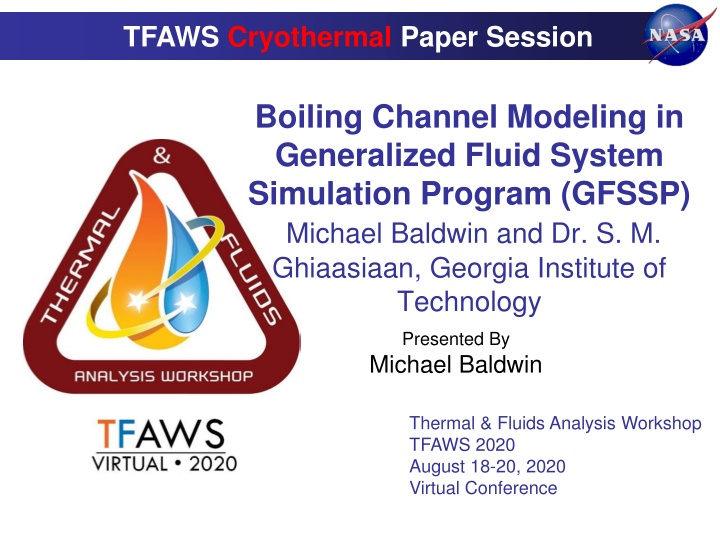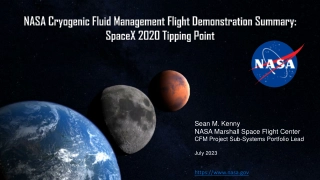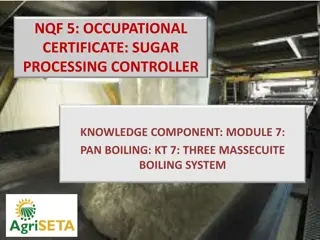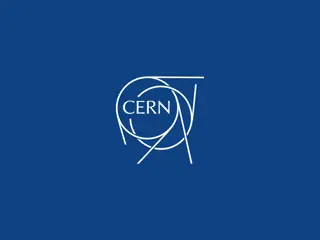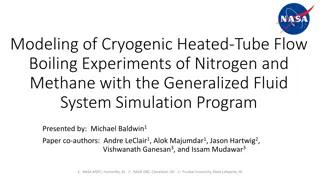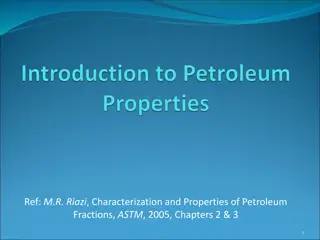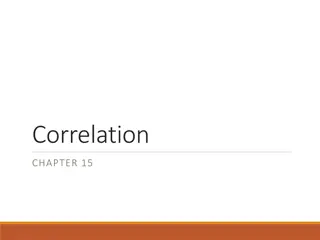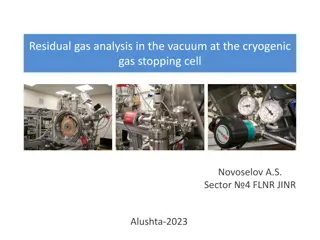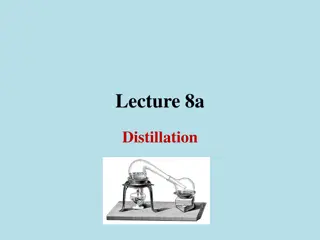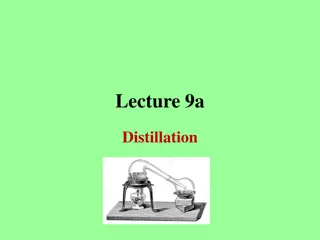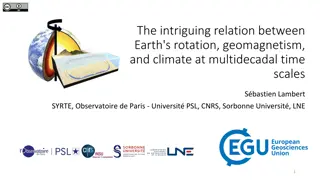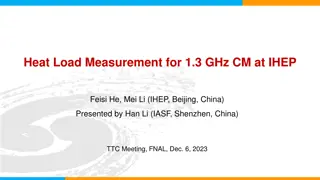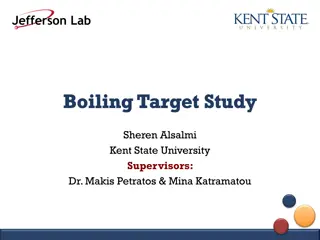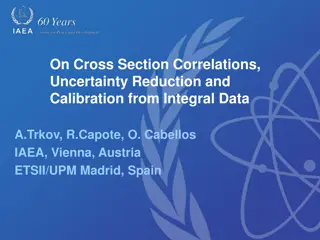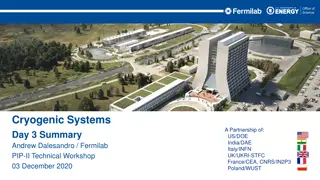Cryogenic Flow Boiling Modeling in GFSSP: Implementation and Correlations
This paper presents the development and implementation of a flow boiling model into GFSSP, focusing on cryogenic fluids LH2, LCH4, and LO2. It covers the current state of cryogenic flow boiling, available test data, key regimes like onset of nucleate boiling, and high heat flux regimes. The presentation outlines the objective, structure, and capabilities of GFSSP, along with predictions using test data examples. Additionally, it discusses available cryogenic boiling correlations from experimental data.
Uploaded on Feb 18, 2025 | 1 Views
Download Presentation

Please find below an Image/Link to download the presentation.
The content on the website is provided AS IS for your information and personal use only. It may not be sold, licensed, or shared on other websites without obtaining consent from the author.If you encounter any issues during the download, it is possible that the publisher has removed the file from their server.
You are allowed to download the files provided on this website for personal or commercial use, subject to the condition that they are used lawfully. All files are the property of their respective owners.
The content on the website is provided AS IS for your information and personal use only. It may not be sold, licensed, or shared on other websites without obtaining consent from the author.
E N D
Presentation Transcript
TFAWS Cryothermal Paper Session Boiling Channel Modeling in Generalized Fluid System Simulation Program (GFSSP) Michael Baldwin and Dr. S. M. Ghiaasiaan, Georgia Institute of Technology Presented By Michael Baldwin Thermal & Fluids Analysis Workshop TFAWS 2020 August 18-20, 2020 Virtual Conference
Presentation Outline Objective: Develop and implement a flow boiling model into GFSSP, with emphasis on fluids LH2, LCH4, and LO2. Part I: The current state of cryogenic flow boiling Brief review of flow boiling Available test data and developed correlations for cryogens Part II: Flow boiling implementation into GFSSP Brief overview of the GFSSP structure and capability GFSSP predictions with example test data TFAWS 2020 August 18-20, 2020 2
Part I: The current state of cryogenic flow boiling LO2 LCH4 [1] TFAWS 2020 August 18-20, 2020 3
Low heat flux regimes Dispersed Flow Boiling Dryout Subcooled and Saturated Nucleate Boiling Onset of Nucleate Boiling (ONB) Twall TFAWS 2020 August 18-20, 2020 4
High heat flux regimes Dispersed Flow Boiling Quality/Void fraction threshold Film Boiling Departure from Nucleate Boiling (DNB) Subcooled and Saturated Nucleate Boiling Onset of Nucleate Boiling (ONB) Twall TFAWS 2020 August 18-20, 2020 5
Available test data LCH4 LO2 7 useful experiments: 3 include nucleate boiling 5 include film boiling 1 includes CHF 5 useful experiments: 5 include nucleate boiling 1 includes film boiling 1 includes CHF 1 useful experiment*: 0 include nucleate boiling 0 include film boiling 1 includes CHF *two supercritical experiments were found but not included TFAWS 2020 August 18-20, 2020 6
Available cryogenic boiling correlations The following correlations used cryogenic experimental data in their development: Klimenko (1982) [2] Nucleate boiling 312 data points (77.4% N2, 20.0% Ne, 2.6% H2) Steiner and Taborek (1992) [3] Nucleate boiling Over 13,000 data points [water, refrigerants, hydrocarbons, and cryogens (including CH4, H2, and O2)] Some of the experimental studies contain correlations that fit their own data TFAWS 2020 August 18-20, 2020 7
Part I Summary To appropriately model flow boiling, the following general heat transfer regimes need to be considered: Subcooled and saturated nucleate boiling Film boiling Dispersed flow boiling Models for the transition between these regimes are also required: Onset of nucleate boiling (ONB) Departure from nucleate boiling (DNB) Dryout Flow boiling test data and heat transfer correlations specific to cryogens are severely lacking TFAWS 2020 August 18-20, 2020 8
Part II: Flow boiling implementation into GFSSP TFAWS 2020 August 18-20, 2020 9
Generalized Fluid System Simulation Program (GFSSP) System level CFD code developed at NASA in the early 90s Fluid Nodes: mass and energy equations are solved for pressures and enthalpies Fluid Branches: momentum equation is solved for flowrates Fluid Boundary Nodes Fluid-to-Solid Conductors: conjugate heat transfer Solid Nodes: heat source supplied Solid-to-Solid Conductors TFAWS 2020 August 18-20, 2020 10
Flow boiling model in progress START NO YES > ? YES NO NO YES ONB? > 0.999 NO YES OSV? NO YES DNB/ Dryout Vapor forced convection NO YES DNB? Subcooled nucleate boiling* Liquid forced convection Saturated nucleate boiling Subcooled nucleate boiling Film/ Dispersed flow boiling Film/ Dispersed flow boiling EXIT *Partial boiling EXIT EXIT EXIT EXIT EXIT EXIT 11
Current GFSSP flow boiling model START Vapor forced convection Liquid forced convection ? > 1 ? < 0 0 ? 1 Film/ Dispersed flow boiling Post-CHF boiling correlation of Miropolski (1963) [4] (developed using water test data): ?? ?, ?????= ??? 0.4 1 ?0.4 ?? ?? 0.8??? 0.4? 1 ? , and = 0.023????? ? + ?? ?? 1 ? = 1 0.1 TFAWS 2020 August 18-20, 2020 12
Correlations with good agreement Chen (1966) [5], saturated nucleate boiling: = ?????? + ?????? ????? found from the pool boiling correlation of Forster and Zuber (1955) ????? found from the forced convection Dittus-Boelter correlation (1930) Steiner and Taborek (1992), saturated nucleate boiling: 13 3 3+ ?????? = ??????? ??? is unique to the boiling fluid and provided by the authors ????? found from the forced convection Gneilinski correlation (1976) Groeneveld (1973) [4], dispersed flow/film boiling: = ? ???? +?? ?? ?? ?? ? ????? 1 ? ??? ? 0.4 1 ?0.4 ? = 1 0.1 1 13 TFAWS 2020 August 18-20, 2020
Preliminary Results: LCH4 nucleate boiling Test Data: Wang et al. (2014) [6] TFAWS 2020 August 18-20, 2020 14
Preliminary Results: LCH4 nucleate boiling 12000 Steiner average difference: -23.33% Chen average difference: -21.93% 10000 8000 h [W/m2 K] Wang test data 6000 GFSSP prediction (Steiner) GFSSP prediction (Chen) GFSSP prediction (Miropolski) 4000 2000 40 < < 141 0 0.02 0.04 0.06 0.08 0.10 0.12 0.14 0.16 0.18 0.20 x [-] TFAWS 2020 August 18-20, 2020 15
Preliminary Results: LCH4 nucleate boiling 20000 Steiner average difference: -9.87% Chen average difference: -16.73% 18000 16000 14000 12000 h [W/m2 K] Wang test data 10000 GFSSP prediction (Steiner) GFSSP prediction (Chen) 8000 GFSSP prediction (Miropolski) 6000 4000 2000 134 < < 136 0 0.00 10.00 20.00 30.00 40.00 50.00 60.00 70.00 q'' [W/m2] TFAWS 2020 August 18-20, 2020 16
Preliminary Results: LCH4 nucleate boiling 14000 Steiner average difference: -24.55% Chen average difference: -24.27% 12000 10000 8000 h [W/m2 K] Wang test data GFSSP prediction (Steiner) 6000 GFSSP prediction (Chen) GFSSP prediction (Miropolski) 4000 2000 80 < < 133 0 100.00 120.00 140.00 160.00 G [kg/m2 s] 180.00 200.00 220.00 240.00 TFAWS 2020 August 18-20, 2020 17
Preliminary Results: LCH4 nucleate boiling 14000 Steiner average difference: -22.32% Chen average difference: -25.34% 12000 10000 8000 h [W/m2 K] Wang test data GFSSP prediction (Steiner) 6000 GFSSP prediction (Chen) GFSSP prediction (Miropolski) 4000 2000 101 < < 149 0 2.50 3.00 3.50 4.00 4.50 5.00 5.50 6.00 P [bar] TFAWS 2020 August 18-20, 2020 18
Preliminary Results: LH2 film boiling Test Data: Hendricks et al. (1961) [7] TFAWS 2020 August 18-20, 2020 19
Preliminary Results: LH2 film boiling 6.00E+03 5.00E+03 4.00E+03 HTC [W/(m^2 K)] 3.00E+03 2.00E+03 1.00E+03 0.00E+00 0.00 0.05 0.10 0.15 z [m] 0.20 0.25 0.30 GFSSP Hendricks Miropolski Groeneveld correlation TFAWS 2020 August 18-20, 2020 20
Conclusion and Next Steps Conclusion Steiner and Chen correlations are in good agreement and predict select methane test data within ~25% Miropolski correlation is not bad for film boiling of hydrogen, but fails in the nucleate boiling regime Next Steps Determine best correlations for each regime for each cryogenic fluid of interest Implement the full boiling model into GFSSP Develop regime-specific boiling correlations (if possible) Suggest future experiments to begin to fill cryogenic boiling data gaps TFAWS 2020 August 18-20, 2020 21
References [1] Nuclear Power for Everybody. 2020. Nuclear Power: Boiling-Boiling Characteristics. Retrieved from https://www.nuclear-power.net/nuclear-engineering/heat-transfer/boiling- and-condensation/flow-boiling-forced-convection-boiling/ [2] V. Klimenko, "Heat transfer intensity at forced flow boiling of cryogenic liquids in tubes," Cryogenics, vol. 22, no. 11, pp. 569-576, 1982. [3] D. Steiner and J. Taborek, "Flow boiling heat transfer in vertical tubes correlated by an asymptotic model," Heat transfer engineering, vol. 13, no. 2, pp. 43-69, 1992. [4] D. Groeneveld and C. Snoek, "A comprehensive examination of heat transfer correlations suitable for reactor safety analysis," Multiphase Science and Technology, vol. 2, no. 1-4, 1986. [5] J. C. Chen, "Correlation for boiling heat transfer to saturated fluids in convective flow," Industrial & engineering chemistry process design and development, vol. 5, no. 3, pp. 322-329, 1966. [6] S. Wang, M. Gong, G. Chen, Z. Sun, and J. Wu, "Flow boiling heat transfer characteristics of methane in a horizontal tube," in AIP Conference Proceedings, 2014, vol. 1573, no. 1: AIP, pp. 1512-1518. [7] R. C. Hendricks, R. Graham, Y. HAU, and R. Friedman, "Experimental heat transfer and pressure drop of liquid hydrogen flowing through a heated tube," NATIONAL AERONAUTICS AND SPACE ADMINISTRATION WASHINGTON DC, 1961. TFAWS 2020 August 18-20, 2020 22
Questions? TFAWS 2020 August 18-20, 2020 23
